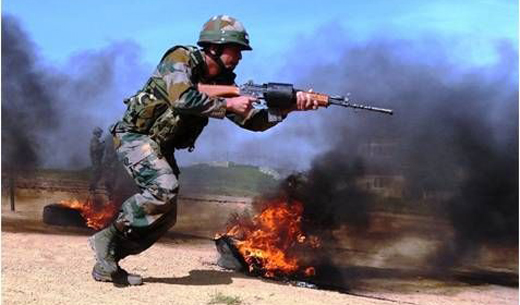Surgical strike: Indian Army inflicted most damage on Lashkar-e-Taiba
Mangalore Today News Network
Oct 10, 2016: The surgical strike conducted by the Indian Army on terror launch pads along the Line of Control (LoC) between India and Pakistan has hurt the proscribed terrorist group Lashkar-e-Taiba (LeT) the most, according to reports that are emerging now. The strike had resulted in razing of seven terror launch pads in Pakistan-occupied Kashmir (PoK), and the death of 38 terrorists.

Founded by Hafiz Saeed, LeT is banned in India, the United States, the United Kingdom, Russia, the European Union and many other nations. The outfit is believed to be responsible for several terror attacks, including the 2001 attack on Parliament in New Delhi. India believes that Saeed is the mastermind behind the 2008 Mumbai terror attacks, however, he manages to roam free in Pakistan.
The Press Trust of India quoted sources with knowledge of the details of the surgical strike as saying that the Indian Army’s field units’ assessment reports gave the impression that the most damage was inflicted on LeT at its Dudniyal terror launch pad in PoK.
The reports, believed to include radio conversations which took place among several of the terror groups, say that the launch pad in Dudniyal was struck by five teams of the Indian Army which consisted of the best of the soldiers from the Kupwara sector of Jammu and Kashmir. The operation led to the death of at least 20 militants.
After the surgical strike on seven terror launch pads, the Indian Army put in place a strict radio-monitoring mechanism in the region, and it helped intercept valuable information of the aftermath of the strike. According to the PTI report, the region where the surgical strike took place saw heavy movement of vehicles belonging to the Pakistan Army, as bodies of the terrorists were cleared away to be buried in the Neelum Valley.
Meanwhile, the Indian Army has provided further proof that Pakistan’s soil is being used to foment and export terrorism into India by making public images of objects obtained from terrorists in the recent Naugam attack which clearly bear Pakistani markings.
- JEE (Main) second edition results to be announced by April 19: NTA
- Three arrested for raping woman in Mangaluru, say police
- Summer rush: Special trains, Vande Bharat sleeper announced for Mangaluru
- Mangaluru: Yellow alert issued as thunderstorms expected across coastal Karnataka
- Mangaluru: Bride-to-be goes missing a day before wedding in Bolar
- Puttur: Grand Brahmarathotsav at Shri Mahalingeshwara Temple draws thousands with devotion and splendor
- Karnataka HC raps state over protest against Waqf Act amid pending SC case
- Fisheries Ministry to launch data collection across the country for Marine Fishers Census from November
- Elephant tries to sneak into house in Mudigere
- Holy Thursday celebrated with solemnity at Our Lady of Miracles Church, Milagres
- ABVP to launch ‘Save Mangalore University’ campaign
- MLA asks corporation to focus on landslip-prone areas and under-construction buildings ahead of Monsoon
- Mangaluru: Woman gang-raped near Netravati river, auto driver among three arrested
- CET row: Karnataka govt orders probe after students asked to remove sacred thread
- Man who flashed woman, assaulted 7 people arrested in Bengaluru
- FIR against Sunny Deol, Randeep Hooda for offending Christian religious sentiments in Jaat
- 22 maoists surrender before security forces in Chhattisgarh’s Sukma
- Indian Embassy repatriates 4 nationals scammed in Myanmar’s Myawaddy
- ED debunks Bengaluru man’s claims of importing Rs 50-crore wolfdog
- Special cabinet meeting on caste census in Karnataka ends without any major decision
- High Court to hear Ranya Rao bail plea on April 21
- India slams Pakistan Army chief’s remarks: ‘Kashmir’s only relation with Pak is…’
- Removal of sacred thread at CET centre in Shivamogga triggers row
- JD Vance, wife Usha to visit India from April 21-24, hold talks with PM Modi
- 22 Naxalites arrested, explosives seized in Chhattisgarh
- Skills and Competencies Take Center Stage at MSN Dialogue Series
- Court remands Maoist Lakshmi to six-day police custody
- Sandhya Shenoy honored with Society for Materials Chemistry Medal-2024
- White Cornus Apartment in Mangaluru
- City girl wins first place in state-level spell bee competition
- Alleged ‘Love Jihad’ Case in Mangaluru: Woman left home voluntarily, says police
- Girl fatally struck by reckless two-wheeler near Belman
- New residential complex for the judges inaugurated in Mangaluru
- Absconding accused nabbed after 8 years
- Truck with cylinders turns turtle in Beltangady
- Bhoota Kola artist dies of cardiac arrest
- Development of the country should be our goal: Ganesh Karnik
- Container truck gets stuck under Modankap railway bridge
- Truck crushes bike’s pillion rider near BC Road
- Head constable dies of heart attack
- CITY INFORMATION
- TRAVEL
- TOURIST INFORMATION
- HEALTH CARE
- MISCELLANEOUS




 Write Comment
Write Comment E-Mail To a Friend
E-Mail To a Friend Facebook
Facebook Twitter
Twitter  Print
Print 


